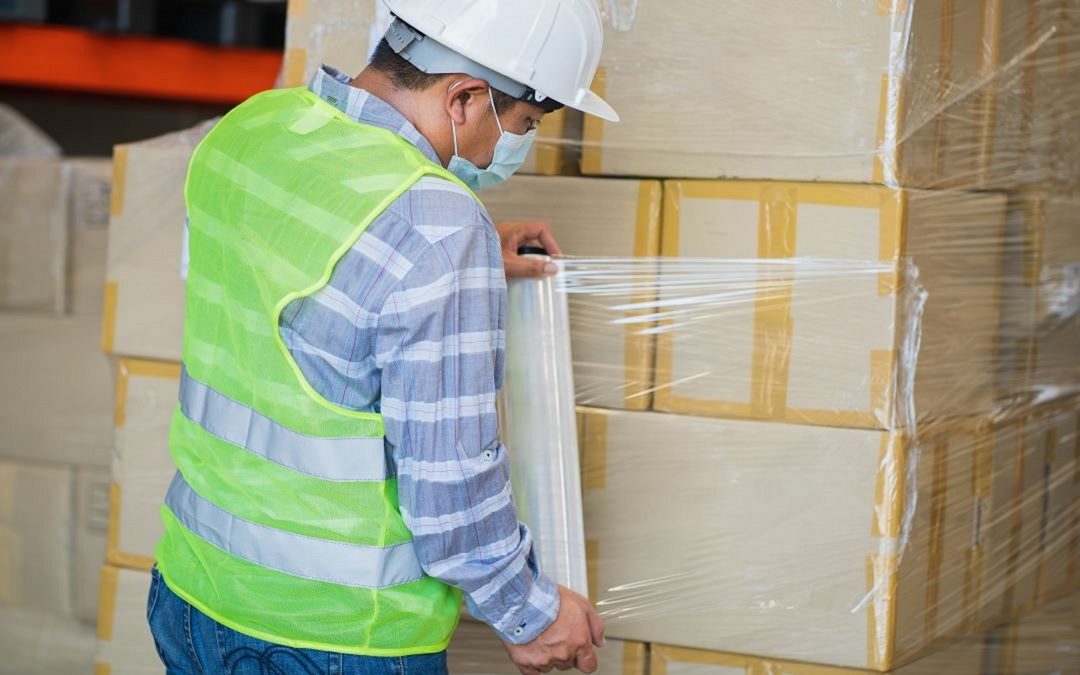When you want to hold several items together for transportation, there are two advised methods that can help keep your items bound together; shrink wrapping and stretch wrapping.
Both methods include tightly binding a thin layer of plastic around the items you wish to bind, holding them together even during potentially vigorous movement. However, both methods are different and yield their own advantages, so it’s important to know the difference between both of them and how each one works before you make your final choice on what method you choose to use when packaging.
What Is Shrink Wrap?
Shrink wrapping involves loosely covering the group of packages with shrink film, a thin but durable material generally made from polyolefin plastics. Due to the molecular makeup of these types of plastic, shrink film is designed to contract with heat, shrinking it over the group of packages in order to create a tight seal.
Shrink wrap is incredibly hygienic, protecting the items contained from dust and bacteria, which is one of the reasons it’s commonly implemented in food containment. However, when it comes to packaging, this tight seal can help to protect boxes from even the wettest of conditions, making it optimal for outdoor transportation even in poor weather.
The Advantages Of Using Shrink Wrap
A major benefit of opting for shrink wrap is that its application doesn’t damage your outer packaging. The nature of the shrink film means that, when applied properly, there shouldn’t be any material chafing or scuffing. While you do need a heat gun or another form of heating machine to apply it properly, possession of one makes the job incredibly easy.
Rather than having to thoroughly wrap plastic around the packages, shrink wrapping saves you time and effort, as it only requires a single, loosely wrapped layer while the heat gun does the rest of the work for you.
Finally, shrink wrap offers the versatility to seal it in a way that it’s still ventilated. A major concern when transporting packages is that they get wet, and moisture can end up sealed within the group of packages by using different types of packaging supplies. However, with shrink film, you avoid any potential damage from excess moisture.
What Are The Different Types Of Shrink Wrap?
Shrink wrap can vary greatly depending on its purpose. For protecting boats against the weather, boat shrink wrap is implemented. Whereas, when you need to wrap a cylindrical object, or if you need a precut sleeve, then shrink tubing is often the go-to option. However, the most common form of shrink wrap is provided in large rolls.
There are three main types of shrink wrap rolls, each categorized by the type of material they use. Each material has its own advantages and situations in which they’re more suited for.
PVC Shrink Wrap
PVC is cheap and light, and once dominated the market as the go-to shrink wrap. Its rigidity makes it ideal for heavier packages, however, it’s recommended that any load using PVC shrink wrap is kept in a well-ventilated area. PVC is made up of many harmful chemicals, thus it should be handled with caution.
Polyolefin Shrink Wrap
As mentioned above, polyolefin (or POF) is the most common type of material used in the creation of shrink wrap. It’s durable, creates a strong seal, and is very puncture resistant. Additionally, POF shrink wrap is incredibly safe, and is FDA-approved, causing no protection risks to the packager.
Polyethylene Shrink Wrap
Also known as PE shrink wrap, Polyethylene is quickly becoming a strong alternative to PVC when it comes to larger or heavier items. While more expensive, this material is firmer and can have designs printed upon it without weakening its structural integrity.
What Is Stretch Wrap?
Unlike shrink wrap which is wrapped loosely and then sealed with heat, stretch wrapping involves stretching flexible plastic around the products to keep them in place. A group of packages are typically wrapped in the stretch film multiple times to help keep the packages together.
The Advantages Of Using Stretch Wrap
Stretch wrap is much cheaper than other types of plastic wrap, making it one of the most economical packaging supplies. Stretch wrap also keeps dirt and moisture away from the packages and certain types of stretch wrap also offer UV protection. It doesn’t need any special equipment and you layer multiple pieces of stretch wrap on an item/items to create as tight of a seal as possible.
Stretch film is super versatile and can be used on any shape or size of product you wish to wrap. It’s ideal for short transportation, as its low retail price means it can be used as frequently as needed without costing you a lot of money.
What Are The Different Types Of Stretch Wrap?
Unlike shrink wrap, stretch wrap comes in a wide array of forms, predominantly determined by the method you use to wrap the packaging. Here are some examples:
Hand Stretch Wrap
This type of hand stretch film is produced in the form of long rolls, designed to be easy for people to unravel and use by hand. It’s the type of stretch wrap that is most commonly found in kitchens across the world for keeping food safe but is widely implemented in the packaging industry too.
Hand stretch wrap can be subdivided further into multiple categories. These categories include: cast, blown, pre-stretch, bundling, identi-wrap, and anti-static.
Machine Stretch Wrap
Machine stretch wrap is designed for industrial level jobs and is compatible with a number of different packaging machines. This method is designed to reduce labor costs and valuable time, requiring minimal input from workers.
Machine stretch film can be further divided into the blown and cast subcategories, depending on how the machine operates.
If You Are In Need Of Shrink And Stretch Wrap, Contact The Packaging Company Today!
We at The Packaging Company believe in providing high-quality packaging supplies at reasonable prices. We ship all across Canada and the United States and offer a wide array of packaging supplies, including many different options of shrink and stretch wrap. To find out how we can assist you with all of your packaging needs, get in touch with us today!




